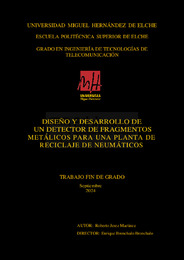Please use this identifier to cite or link to this item:
https://hdl.handle.net/11000/33942Diseño y desarrollo de un detector de fragmentos metálicos para una planta de reciclaje de neumáticos
| Title: Diseño y desarrollo de un detector de fragmentos metálicos para una planta de reciclaje de neumáticos |
| Authors: Jerez Martínez, Roberto |
| Tutor: Bronchalo, Enrique |
| Editor: Universidad Miguel Hernández de Elche |
| Department: Departamentos de la UMH::Ingeniería de Comunicaciones |
| Issue Date: 2024-09 |
| URI: https://hdl.handle.net/11000/33942 |
| Abstract: Este trabajo de fin de grado se centra en el diseño y desarrollo de un dispositivo detector de piezas metálicas, abordando un problema práctico en el proceso de reciclaje de neumáticos. En la actualidad, la implementación de tecnología moderna en algunas etapas del reciclaje de neumáticos es muy limitada. Este estudio se enfoca en una de las primeras fases del proceso: la cinta transportadora que mueve trozos de neumático de dimensiones del orden de 10 cm. En esta etapa, un operario realiza inspecciones visuales para garantizar que no se transporten objetos metálicos no deseados como tornillos, remaches o pequeños fragmentos de hierro hacia la siguiente fase, la máquina granuladora. Esta máquina, equipada con unas cuchillas giratorias de acero, puede requerir elevados gastos de mantenimiento o sustitución cuando procesa accidentalmente estos materiales metálicos indeseados. La solución propuesta en esta memoria utiliza una combinación de espiras inductoras y detectoras balanceadas para identificar la presencia de metales no deseados en la cinta mediante la alteración del campo magnético generada por los elementos metálicos. Siendo más precisos, el sistema se compone de una espira inductora primaria y dos bobinas laterales detectoras, que operan según la ley de inducción electromagnética de Faraday. El campo magnético de la espira primaria genera corrientes de Foucault en los objetos metálicos, las cuales generan a su vez campos magnéticos que alteran el flujo detectado por las espiras secundarias. En relación con la estructura de nuestro sistema, cuenta con bobinas rectangulares, diseñadas específicamente para ajustarse a las limitaciones físicas de la disposición de la cinta transportadora. Durante el desarrollo del sistema, se realizaron diversas pruebas y análisis con el objetivo de optimizar el detector de la manera más eficiente, además de tener en cuenta que se ajustara adecuadamente a las necesidades operativas reales de la planta de reciclaje. Finalmente, los resultados obtenidos alcanzaron los objetivos planteados, por lo que sería posible lograr una reducción significativa en el error humano, un aumento en la seguridad operacional y una reducción en los gastos de mantenimiento y de personal en las plantas de reciclaje de neumáticos. Los trabajos futuros se centrarán en perfeccionar los algoritmos de detección y en extender su uso a otras aplicaciones en las que existan riesgos similares. This final degree project focuses on the design and development of a metal piece detector device, addressing a practical problem in the tire recycling process. Currently, the implementation of modern technology in some stages of tire recycling is very limited. This study focuses on one of the first phases of the process: the conveyor belt that moves tire pieces of dimensions in the order of 10 cm. At this stage, an operator performs visual inspections to ensure that unwanted metal objects, such as screws, rivets, or small iron fragments, are not transported to the next stage, the granulator machine. This machine, equipped with rotating steel blades, can require high maintenance or replacement costs when it accidentally processes these unwanted metallic materials. The solution proposed in this report uses a combination of balanced inductive and detector coils to identify the presence of unwanted metals on the conveyor by detecting the magnetic field alteration caused by metallic elements. More specifically, the system consists of a primary inductive coil and two side detector coils, which operate according to Faraday's law of electromagnetic induction. The magnetic field from the primary coil generates eddy currents in metallic objects, which in turn generate magnetic fields that alter the flux detected by the secondary coils. Regarding the structure of our system, it features rectangular coils, specifically designed to fit the physical limitations of the conveyor belt setup. During the development of the system, various tests and analyses were conducted with the aim of optimizing the detector in the most efficient way, while also ensuring that it appropriately meets the real operational needs of the recycling plant. Finally, the results obtained met the stated objectives, making it possible to significantly reduce human error, increase operational safety, and reduce maintenance and personnel costs at tire recycling plants. Future work will focus on refining the detection algorithms and extending their use to other applications where similar risks exist. |
| Keywords/Subjects: detector de metales inducción electromagnética corrientes de foucault eddy currents espiras balanceadas balanced coils waveforms circuito electrónico analógico |
| Knowledge area: CDU: Ciencias aplicadas: Ingeniería. Tecnología |
| Type of document: info:eu-repo/semantics/bachelorThesis |
| Access rights: info:eu-repo/semantics/openAccess Attribution-NonCommercial-NoDerivatives 4.0 Internacional |
| Appears in Collections: TFG- Ingeniería de Tecnologías de Telecomunicación |
.png)

